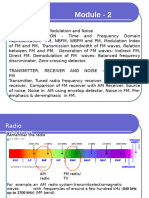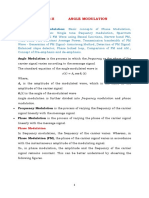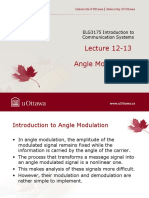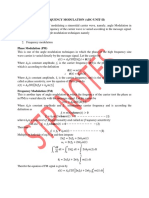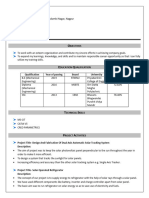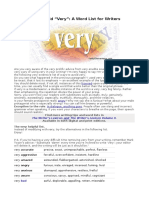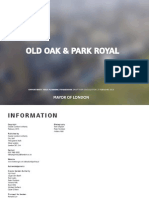Narrow-Band Frequency Modulation: Lecture #16, May 3, 2011
Uploaded by
deepam0187Narrow-Band Frequency Modulation: Lecture #16, May 3, 2011
Uploaded by
deepam0187Narrow-band Frequency
Modulation
KEEE343 Communication Theory
Lecture #16, May 3, 2011
Prof. Young-Chai Ko
koyc@korea.ac.kr
Summary
Narrowband Frequency Modulation
Wideband Frequency Modulation
Narrow-Band Frequency Modulation
Narrow-Band FM means that the FM modulated wave has narrow
bandwidth.
Consider the single-tone wave as a message signal:
FM signal
Instantaneous frequency
Phase
m(t) = A
m
cos(2f
m
t)
f
i
(t) = f
c
+ k
f
A
m
cos(2f
m
t)
= f
c
+f cos(2f
m
t)
i
(t) = 2
Z
t
0
f
i
() d = 2
f
c
t +
f
2f
m
sin(2f
m
t)
= 2f
c
t +
f
f
m
sin(2f
m
t)
f = k
f
A
m
Denitions
Phase deviation of the FM wave
Modulation index of the FM wave:
Then, FM wave is
To be narrow-band FM, should be small.
For small compared to 1 radian, we can rewrite
=
f
f
m
s(t) = A
c
cos[2f
c
t + sin(2f
m
t)]
f
m
s(t) A
c
cos(2f
c
t) A
c
sin(2f
c
t) sin(2f
m
t)
s(t) = A
c
cos(2f
c
t) cos( sin(2f
m
t)) A
c
sin(2f
c
t) sin( sin(2f
m
t))
cos[ sin(2f
m
t)] 1, sin[ sin(2f
m
t)] sin(2f
m
t)
[Ref: Haykin & Moher, Textbook]
Consider the modulated signal
which can be rewritten as
where
and
Polar Representation from Cartesian
s(t) = a(t) cos(2f
c
t +(t))
s(t) = s
I
(t) cos(2f
c
t) s
Q
(t) sin(2f
c
t)
s
I
(t) = a(t) cos((t)), and, s
Q
(t) = a(t) sin((t))
a(t) =
s
2
I
(t) + s
2
Q
(t)
1
2
, and (t) = tan
1
s
Q
(t)
s
I
(t)
Approximated narrow-band FM signal can be written as
Envelope
Maximum value of the envelope
Minimum value of the envelope
s(t) A
c
cos(2f
c
t) A
c
sin(2f
c
t) sin(2f
m
t)
for small
a(t) = A
c
1 +
2
sin
2
(2f
m
t)
A
c
1 +
1
2
2
sin
2
(2f
m
t)
A
max
= A
c
1 +
1
2
A
min
= A
c
The ratio of the maximum to minimum value
Rewriting the approximated narrow-band FM wave is
Average power
Average power of the unmodulated wave
A
max
A
min
=
1 +
1
2
s(t) A
c
cos(2f
c
t) +
1
2
cos(2(f
c
+ f
m
)t)
1
2
A
c
cos(2(f
c
f
m
)t)
P
av
=
1
2
A
2
c
+
1
2
A
c
2
+
1
2
A
c
2
=
1
2
A
2
c
(1 +
2
)
P
c
=
1
2
A
2
c
Ration of the average power to the power of the unmodulated wave
Comparison with the AM signal
Approximated Narrow-band FM signal
AM signal
P
av
P
c
= 1 +
2
s(t) A
c
cos(2f
c
t) +
1
2
cos(2(f
c
+ f
m
)t)
1
2
A
c
cos(2(f
c
f
m
)t)
s
AM
(t) = A
c
cos(2f
c
t) +
1
2
A
c
{cos[2(f
c
+ f
m
)t)] + cos[2(f
c
f
m
)t]}
difference between the narrow-band FM and AM waves
Bandwidth of the narrow-band FM:
Phasor interpretation
2f
m
[Ref: Haykin & Moher, Textbook]
Angle
Using the power series of the tangent function such as
(t) = 2f
c
t +(t) = 2f
c
t + tan
1
( sin(2f
m
t))
tan
1
(x) x
1
3
x
3
+
Angle can be approximated as
Ideally, we should have
The harmonic distortion value is
The maximum absolute value of D(t) is
(t) 2f
c
t + sin(2f
m
t)
D(t) =
3
3
sin
3
(2f
m
t)
(t) 2f
c
t + sin(2f
m
t)
1
3
3
sin
3
(2f
m
t)
D
max
=
3
3
For example for
which is small enough for it to be ignored in practice.
= 0.3,
D
max
=
0.3
3
3
= 0.009 1%
Amplitude Distortion of Narrow-band FM
Ideally, FM wave has a constant envelope
But, the modulated wave produced by the narrow-band FM differ from
this ideal condition in two fundamental respects:
The envelope contains a residual amplitude modulation that varies
with time
The angle contains harmonic distortion in the form of third-
and higher order harmonics of the modulation frequency
i
(t)
f
m
Wide-Band Frequency Modulation
Spectral analysis of the wide-band FM wave
or
where is called complex envelope.
Note that the complex envelope is a periodic function of time with a
fundamental frequency which means
where
s(t) = A
c
cos[2f
c
t + sin(2f
m
t)]
s(t) = <[A
c
exp[j2f
c
t + j sin(2f
m
t)]] = <[ s(t) exp(j2f
c
t)]
s(t) = A
c
exp [j sin(2f
m
t)]
f
m
s(t) = s(t + kT
m
) = s(t +
k
f
m
)
T
m
= 1/f
m
Then we can rewrite
Fourier series form
where
s(t) =
X
n=
c
n
exp(j2nf
m
t)
c
n
= f
m
Z
1/(2f
m
)
1/(2f
m
)
s(t) exp(j2nf
m
t) dt
= f
m
A
c
Z
1/(2f
m
)
1/(2f
m
)
exp[j sin(2f
m
t) j2nf
m
t] dt
s(t) = s(t + k/f
m
)
= A
c
exp[j sin(2f
m
(t + k/f
m
))]
= A
c
exp[j sin(2f
m
t + 2k)]
= A
c
exp[j sin(2f
m
t)]
Dene the new variable:
Then we can rewrite
nth order Bessel function of the rst kind and argument
Accordingly
which gives
x = 2f
m
t
c
n
=
A
c
2
Z
exp[j( sin x nx)] dx
J
n
() =
1
2
Z
exp[j( sin x nx)] dx
c
n
= A
c
J
n
()
s(t) = A
c
X
n=
J
n
() exp(j2nf
m
t)
Then the FM wave can be written as
Fourier transform
which shows that the spectrum consists of an innite number of delta
functions spaced at for
s(t) = <[ s(t) exp(j2f
c
t)]
= <
"
A
c
X
n=
J
n
() exp[j2n(f
c
+ f
m
)t]
#
= A
c
X
n=
J
n
() cos[2(f
c
+ nf
m
)t]
S(f) =
A
c
2
X
n=
J
n
() [(f f
c
nf
m
) + (f +f
c
+nf
m
)]
f = f
c
nf
m
n = 0, +1, +2, ...
1. For different values of n
2. For small value of
6. The equality holds exactly for arbitrary
Properties of Single-Tone FM for Arbitrary Modulation
Index
J
n
() = J
n
(), for n even
J
n
() = J
n
(), for n odd
J
0
() 1,
J
1
()
2
J
n
() 0, n > 2
X
n=
J
2
n
() = 1
[Ref: Haykin & Moher, Textbook]
1. The spectrum of an FM wave contains a carrier component and and an innite
set of side frequencies located symmetrically on either side of the carrier at
frequency separations of ...
2. The FM wave is effectively composed of a carrier and a single pair of side-
frequencies at .
3. The amplitude of the carrier component of an FM wave is dependent on the
modulation index . The averate power of such as signal developed across a 1-
ohm resistor is also constant:
The average power of an FM wave may also be determined from
f
m
, 2f
m
, 3f
m
f
c
f
m
P
av
=
1
2
A
2
c
P
av
=
1
2
A
2
c
X
n=
J
2
n
()
You might also like
- Presentation 25233 Content Document 20241001104558AMNo ratings yetPresentation 25233 Content Document 20241001104558AM93 pages
- Handout 7: Phase and Frequency ModulationNo ratings yetHandout 7: Phase and Frequency Modulation7 pages
- Analog Communication Systems: Angle Modulation100% (1)Analog Communication Systems: Angle Modulation36 pages
- Angle Modulation: Gaurav S. Kasbekar Dept. of Electrical Engineering IIT BombayNo ratings yetAngle Modulation: Gaurav S. Kasbekar Dept. of Electrical Engineering IIT Bombay29 pages
- Narrow-Band FM and Wide-Band FM: Presented by N.A.Pappathi Ap / Ece, NprcetNo ratings yetNarrow-Band FM and Wide-Band FM: Presented by N.A.Pappathi Ap / Ece, Nprcet32 pages
- Chapter 3: FM Modulation: Modulation in Which The Angle of The Carrier Wave Is Varied According To The Base-BandNo ratings yetChapter 3: FM Modulation: Modulation in Which The Angle of The Carrier Wave Is Varied According To The Base-Band33 pages
- Freqency Modulation - 3rd P&M - 2019-2020No ratings yetFreqency Modulation - 3rd P&M - 2019-20207 pages
- L17 - AC - 11.03.2025 - FM Signal RepresentationNo ratings yetL17 - AC - 11.03.2025 - FM Signal Representation16 pages
- Chapter 5.1, Carlson, Communication Systems: ReferenceNo ratings yetChapter 5.1, Carlson, Communication Systems: Reference15 pages
- Reference: - Chapter 5.1, Carlson, Communication SystemsNo ratings yetReference: - Chapter 5.1, Carlson, Communication Systems15 pages
- Introduction To Analog and Digital Communication: Chapter 4No ratings yetIntroduction To Analog and Digital Communication: Chapter 463 pages
- Emission - Réception - Chaptre III - AnglaisNo ratings yetEmission - Réception - Chaptre III - Anglais4 pages
- ) 2 Sin ) 2 Sin (Sin (1) ) 2 Sin (Cos (: T F T F T FNo ratings yet) 2 Sin ) 2 Sin (Sin (1) ) 2 Sin (Cos (: T F T F T F37 pages
- Unit - 3: T Acos T C A Amplitude of The CarrierNo ratings yetUnit - 3: T Acos T C A Amplitude of The Carrier23 pages
- Reference: Communication Systems-Simon Haykin (2001)No ratings yetReference: Communication Systems-Simon Haykin (2001)33 pages
- Narrow-Band Frequency Modulation: M (T) A Cos (2 F T)No ratings yetNarrow-Band Frequency Modulation: M (T) A Cos (2 F T)2 pages
- Angle Modulation and Demodulation: EELE 3370No ratings yetAngle Modulation and Demodulation: EELE 337028 pages
- Analog Communication: Gokaraju Rangaraju Institute of Engineering & Technology (Autonomous)No ratings yetAnalog Communication: Gokaraju Rangaraju Institute of Engineering & Technology (Autonomous)33 pages
- Feynman Lectures Simplified 2C: Electromagnetism: in Relativity & in Dense MatterFrom EverandFeynman Lectures Simplified 2C: Electromagnetism: in Relativity & in Dense MatterNo ratings yet
- Hyrdoacoustic Ocean Exploration: Theories and Experimental ApplicationFrom EverandHyrdoacoustic Ocean Exploration: Theories and Experimental ApplicationNo ratings yet
- Discombobulator Mini-Tutorial (Evan's Plugins)100% (1)Discombobulator Mini-Tutorial (Evan's Plugins)3 pages
- Factors Affecting Centralisation and Decentralisation: Presented By:-Himanshu SharmaNo ratings yetFactors Affecting Centralisation and Decentralisation: Presented By:-Himanshu Sharma12 pages
- Gradient-Based Feature Extraction From Raw Bayer Pattern ImagesNo ratings yetGradient-Based Feature Extraction From Raw Bayer Pattern Images12 pages
- CUADERNILLO B Unidad 1 de Segundo Año InglesNo ratings yetCUADERNILLO B Unidad 1 de Segundo Año Ingles8 pages
- AE2 Speaking Midterm April.2022 - Topic and InstructionsNo ratings yetAE2 Speaking Midterm April.2022 - Topic and Instructions1 page
- Draft Old Oak and Park Royal Opportunity Area Planning FrameworkNo ratings yetDraft Old Oak and Park Royal Opportunity Area Planning Framework130 pages
- Industrial Engineering Mec 422 2 Unit Course Note WK1-3No ratings yetIndustrial Engineering Mec 422 2 Unit Course Note WK1-38 pages
- [Ebooks PDF] download Brain-Computer Interfaces (Volume 168) (Handbook of Clinical Neurology, Volume 168) 1st Edition Michael J. Aminoff full chapters100% (2)[Ebooks PDF] download Brain-Computer Interfaces (Volume 168) (Handbook of Clinical Neurology, Volume 168) 1st Edition Michael J. Aminoff full chapters51 pages
- Foundations of Library and Information Science 4th Edition Richard E. Rubin download pdf100% (1)Foundations of Library and Information Science 4th Edition Richard E. Rubin download pdf81 pages
- Presentation 25233 Content Document 20241001104558AMPresentation 25233 Content Document 20241001104558AM
- Angle Modulation: Gaurav S. Kasbekar Dept. of Electrical Engineering IIT BombayAngle Modulation: Gaurav S. Kasbekar Dept. of Electrical Engineering IIT Bombay
- Narrow-Band FM and Wide-Band FM: Presented by N.A.Pappathi Ap / Ece, NprcetNarrow-Band FM and Wide-Band FM: Presented by N.A.Pappathi Ap / Ece, Nprcet
- Chapter 3: FM Modulation: Modulation in Which The Angle of The Carrier Wave Is Varied According To The Base-BandChapter 3: FM Modulation: Modulation in Which The Angle of The Carrier Wave Is Varied According To The Base-Band
- Chapter 5.1, Carlson, Communication Systems: ReferenceChapter 5.1, Carlson, Communication Systems: Reference
- Reference: - Chapter 5.1, Carlson, Communication SystemsReference: - Chapter 5.1, Carlson, Communication Systems
- Introduction To Analog and Digital Communication: Chapter 4Introduction To Analog and Digital Communication: Chapter 4
- ) 2 Sin ) 2 Sin (Sin (1) ) 2 Sin (Cos (: T F T F T F) 2 Sin ) 2 Sin (Sin (1) ) 2 Sin (Cos (: T F T F T F
- Reference: Communication Systems-Simon Haykin (2001)Reference: Communication Systems-Simon Haykin (2001)
- Narrow-Band Frequency Modulation: M (T) A Cos (2 F T)Narrow-Band Frequency Modulation: M (T) A Cos (2 F T)
- Analog Communication: Gokaraju Rangaraju Institute of Engineering & Technology (Autonomous)Analog Communication: Gokaraju Rangaraju Institute of Engineering & Technology (Autonomous)
- Feynman Lectures Simplified 2C: Electromagnetism: in Relativity & in Dense MatterFrom EverandFeynman Lectures Simplified 2C: Electromagnetism: in Relativity & in Dense Matter
- Hyrdoacoustic Ocean Exploration: Theories and Experimental ApplicationFrom EverandHyrdoacoustic Ocean Exploration: Theories and Experimental Application
- Factors Affecting Centralisation and Decentralisation: Presented By:-Himanshu SharmaFactors Affecting Centralisation and Decentralisation: Presented By:-Himanshu Sharma
- Gradient-Based Feature Extraction From Raw Bayer Pattern ImagesGradient-Based Feature Extraction From Raw Bayer Pattern Images
- AE2 Speaking Midterm April.2022 - Topic and InstructionsAE2 Speaking Midterm April.2022 - Topic and Instructions
- Draft Old Oak and Park Royal Opportunity Area Planning FrameworkDraft Old Oak and Park Royal Opportunity Area Planning Framework
- Industrial Engineering Mec 422 2 Unit Course Note WK1-3Industrial Engineering Mec 422 2 Unit Course Note WK1-3
- [Ebooks PDF] download Brain-Computer Interfaces (Volume 168) (Handbook of Clinical Neurology, Volume 168) 1st Edition Michael J. Aminoff full chapters[Ebooks PDF] download Brain-Computer Interfaces (Volume 168) (Handbook of Clinical Neurology, Volume 168) 1st Edition Michael J. Aminoff full chapters
- Foundations of Library and Information Science 4th Edition Richard E. Rubin download pdfFoundations of Library and Information Science 4th Edition Richard E. Rubin download pdf



